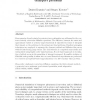Free Online Productivity Tools
i2Speak
i2Symbol
i2OCR
iTex2Img
iWeb2Print
iWeb2Shot
i2Type
iPdf2Split
iPdf2Merge
i2Bopomofo
i2Arabic
i2Style
i2Image
i2PDF
iLatex2Rtf
Sci2ools
MCS
2010
Springer
2010
Springer
Goal-oriented a posteriori error estimates for transport problems
Some aspects of goal-oriented a posteriori error estimation are addressed in the context of steady convection-diffusion equations. The difference between the exact and approximate values of a linear target functional is expressed in terms of integrals that depend on the solutions to the primal and dual problems. Gradient averaging techniques are employed to separate the element residual and diffusive flux errors without introducing jump terms. The dual solution is computed numerically and interpolated using higher-order basis functions. A node-based approach to localization of global errors in the quantities of interest is pursued. A possible violation of Galerkin orthogonality is taken into account. Numerical experiments are performed for centered and upwind-biased approximations of a 1D boundary value problem. Key words: stationary convection-diffusion equations, the finite element method, a posteriori error estimates, goal-oriented quantities, mesh adaptation PACS: 65N15, 65N...
Convection-diffusion Equations | MCS 2010 | Pattern Recognition | Posteriori Error | Posteriori Error Estimation |
| Added | 29 Jan 2011 |
| Updated | 29 Jan 2011 |
| Type | Journal |
| Year | 2010 |
| Where | MCS |
| Authors | Dmitri Kuzmin, Sergey Korotov |
Comments (0)

